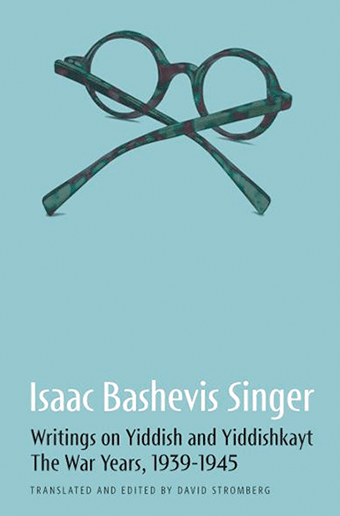Reviewed by NEAL GENDLER
A frequent theme among Isaac Bashevis Singer’s newly translated wartime essays is his lament for the lost world of yiddishkayt, the environment of East European Jews.
“Yiddish language and culture are going through their greatest crisis in history,” Singer wrote for the Dec. 4, 1944, Forverts, the New York-based Yiddish newspaper, later published in English as the Forward. “With the destruction of East European Jewry, the sources of the Yiddish language have also been wiped away.”
The primary reason, he wrote, is destruction of the Jews of Poland, “the home of Yiddish.” Among pieces translated and edited in a new book by David Stromberg, Singer lovingly describes life in a world of Jews: neighborhoods, customs, culture, trade and continuously developing language. The masses of Jews who emigrated to America — as he did in 1935 — live and educate their children in the world of English, he wrote, and with successive generations, the “mama loschen” (mother tongue) is lost.
Yiddishkayt can be “an essence, a quality, a general state of being Ashkenazically Jewish,” and also Judaism as practiced by Ashkenazi Jews, Stromberg says.
In these pieces, core themes “that emerge most tangibly are the anger and anxiety that Singer felt over the apparent indifference of the Jewish sphere — including in the Yiddish world — over the cultural treasures that were in the process of being lost during World War II,” says Stromberg, editor of the Isaac Bashevis Singer Literary Trust, in his excellent introduction. “It was a visceral loss not only of the environment in which he grew up” but also of his mother and older brother.
Stromberg says Singer (1903-1991) wrote for Forverts under three pen names — most in this book as Yitskhok Varshavski. A reader might wonder “about the identity of this Isaac from Warsaw,” Stromberg says. “Whoever he was, he had a lot of opinions about the situation of the Jews in both Europe and the United States, both before and after World War II, as well as the future of Jewish life in America,” topics in which he was heavily invested.
As himself, Singer became known for the short story “Gimpel the Fool” and books such as The Magician of Lublin, The Slave and Enemies: A Love Story. He was awarded the Nobel Prize for Literature in 1978.
Stromberg chose 25 pieces from among more than 150 from 1939 through 1945. The first, from July 16, 1939, is about agunot — wives of missing husbands — revealing rules about identifying a husband’s body for a religious declaration of death. The second to last, from Nov. 20, 1945, is about Jews’ right to their homeland. The last, from Dec. 17, 1945, is about a Yiddish writer’s difficulty outside the vanished Yiddish world.
In between, Singer noted that Jews [then] controlled most U.S. movie companies but avoided making films about Jewish life. “They’re afraid of Jewish topics,” he wrote. “For Hollywood, we don’t exist.”
He criticizes Yiddish literature for mostly portraying Jews “as if they did only one thing: live in tiny shtetls and keep half-empty shops. … A Yiddish literature that is attuned to the greatness of Jewish life in the full sense of the word has never existed.” For this, Stromberg says, Singer began creating a series called “The Family Moskat,” “his first and most elaborate ode to Warsaw Jewry.”
He challenges Jewish religious ignorance in a June 6, 1944, piece that Stromberg titles: “They Don’t Know Why They’re Jewish, But They Don’t Want To Be Anything Else.”
Singer also discusses meanings of Jewish names and immigrants keeping them for religious purposes but Americanizing them for everyday life, such as Yitshkok becoming Isaac or Irving and Chaim becoming Hy or Hyman — understandable, I think, in that time’s antisemitism. (Bar and Bat Mitzva kids’ names now might make his head spin.)
Yet, as Singer said in a public appearance in Minneapolis years ago, Yiddish is not dead. It lives on, mostly in black-hat Orthodox communities, which are large in Israel.
That helps fulfill two of Singer’s wishes. In a Dec. 4, 1944, piece, he wrote that Yiddish “has engraved itself deep into our souls. … whether Yiddish rises or falls, there should still be Jews who are devoted to Yiddish.” He added that “Yiddish literature has to be collected.” Efforts to collect and preserve Yiddish literature are embodied in the 43-year-old Yiddish Book Center, in Amherst, Mass., for which White Goat is an imprint.
***
Neal Gendler is a Minneapolis writer and editor.
(American Jewish World, December 2023)




















